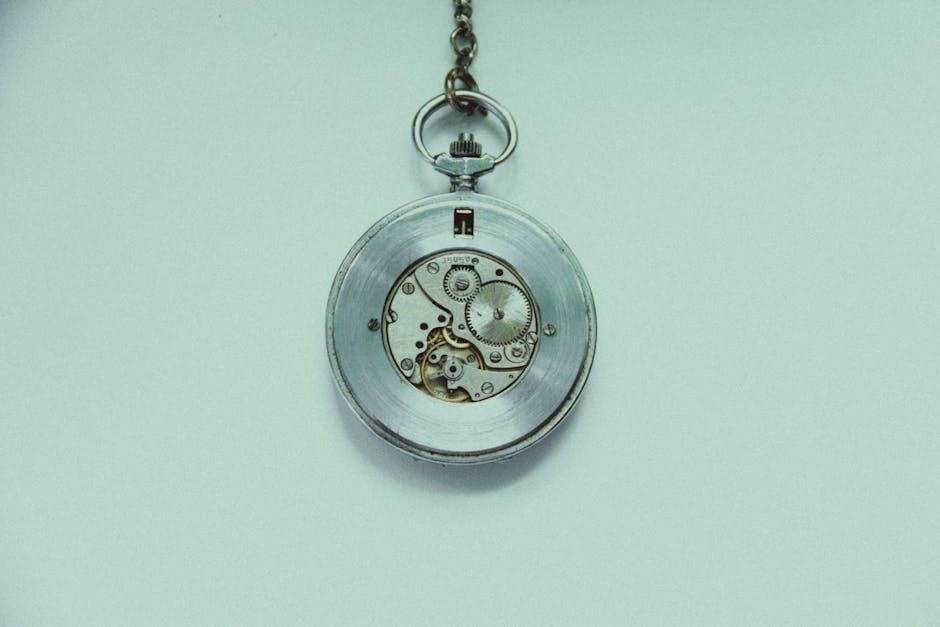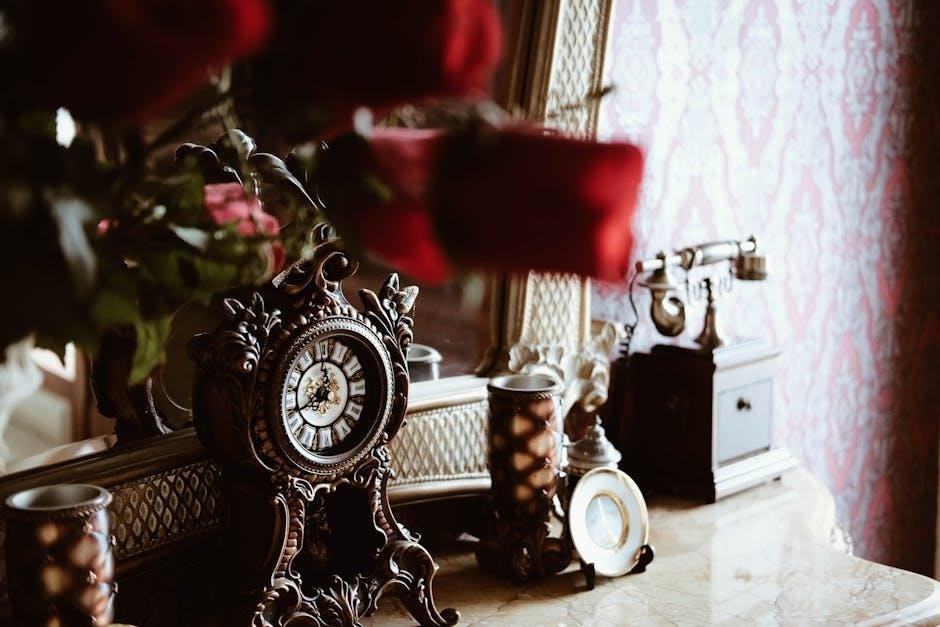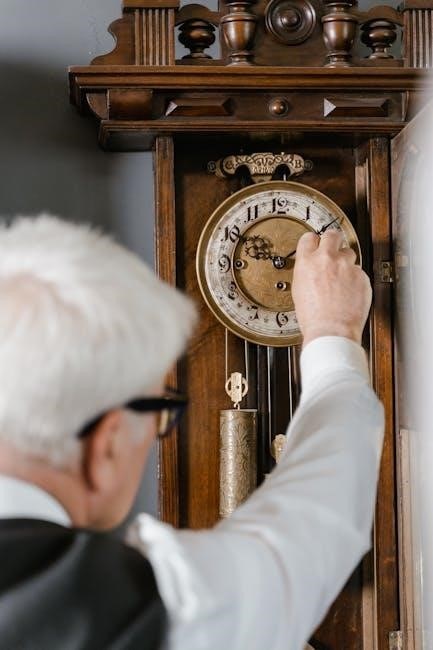Welcome to our comprehensive guide on determining the value of antique clocks. This resource helps collectors and sellers understand key factors like authenticity, rarity, and market trends.
Understanding the Basics of Antique Clocks
Antique clocks are timepieces over 100 years old, valued for their historical significance, craftsmanship, and rarity. Understanding their basics involves knowing types like grandfather, mantel, and wall clocks. Age, condition, and authenticity are critical in determining value. Clocks with original parts, unique mechanisms, or renowned makers often hold higher worth. Researching historical context and market demand is essential for collectors and sellers alike.
Why Antique Clocks Hold Value
Antique clocks hold value due to craftsmanship, historical significance, and rarity. They are treasured for their intricate mechanisms and artistic designs. Market demand, especially for rare or well-preserved models, drives their worth. Additionally, provenance and the reputation of their makers enhance value, making them desirable investments and cherished collector’s items.

Determining the Authenticity of Antique Clocks
Authenticity is verified through signatures, historical records, and expert appraisals, ensuring the clock’s age, originality, and maker align with its claimed heritage and value.
How to Identify Genuine Antique Clocks
To identify genuine antique clocks, look for signatures or maker’s marks, which often appear on the dial or movement. Inspect the materials and craftsmanship, ensuring they align with the clock’s claimed era. Examine historical records or provenance that tie the clock to a specific maker or period. Consulting with experts or appraisers can also verify authenticity, as they can assess intricate details and historical consistency.
Common Mistakes in Authenticating Antique Clocks
A common error is overlooking restored or replaced parts, which can significantly lower a clock’s value. Novice collectors often trust unverified provenance or neglect to consult experts. Additionally, focusing solely on age without considering rarity or condition can lead to inaccurate appraisals. Misjudging reproduction pieces as originals is another frequent mistake, emphasizing the need for thorough research and professional evaluation.

Evaluating the Condition of Antique Clocks
Condition is crucial in determining value. Look for original finishes, minimal wear, and functional mechanics. Damage or significant repairs can lower worth, emphasizing the importance of preservation over restoration.
Key Factors That Affect the Condition
The condition of an antique clock is influenced by factors like originality of parts, wear and tear, and repairs. Environmental exposure, such as moisture or sunlight, can degrade finishes. Mechanical components’ functionality and oxidation levels also play a role. Additionally, past maintenance or improper handling can significantly impact the clock’s overall state and, consequently, its value. These elements must be carefully assessed to determine authenticity and worth.
How Condition Impacts the Value
The condition of an antique clock significantly influences its value. Well-preserved timepieces with original components and minimal repairs typically command higher prices. Damage, wear, or alterations can drastically reduce worth. Functional mechanisms and aesthetic appeal are crucial, as collectors seek pieces that retain historical integrity and craftsmanship. Thus, a clock’s state is a critical factor in determining its market value and desirability among enthusiasts and investors.
Researching the History and Maker of Antique Clocks
Uncover the story behind your antique clock by researching its maker and historical background. This insight enhances its value and connects you to its craftsmanship legacy.
Identifying the Clock Maker
Identifying the clock maker is crucial for determining value. Look for signatures, stamps, or engravings on the dial or movement. Research historical records, maker’s marks, and consult experts to verify authenticity. Knowing the creator can reveal the clock’s origins, rarity, and craftsmanship, significantly impacting its appraisal and market value. This step ensures accuracy in valuation and connects the piece to its heritage.
Historical Background and Provenance
Understanding the historical background and provenance of an antique clock enhances its value. Discovering its origins, historical significance, and ownership history can elevate its appeal. A clock with a documented past, especially ties to notable figures or events, commands higher prices. Provenance acts as a certificate of authenticity, making the timepiece more desirable to collectors and investors seeking rare, storied items.
Assessing the Rarity and Demand of Antique Clocks
Rarity and demand significantly influence an antique clock’s value. Limited production, unique features, and market trends drive desirability and pricing, shaping the collector’s market dynamics effectively.
What Makes an Antique Clock Rare
An antique clock’s rarity stems from factors like unique craftsmanship, historical provenance, and limited production. Rare clocks often feature intricate designs, exclusive mechanisms, or associations with renowned makers. Additionally, clocks with well-documented histories or ties to significant events are highly sought after. Limited editions, one-of-a-kind pieces, and those in exceptional condition further elevate their rarity, making them true treasures for collectors and connoisseurs alike. Market demand also plays a crucial role in defining rarity.
Current Market Trends and Demand
The antique clock market currently faces a surplus of supply over demand, leading to stable or declining prices for common models. However, rare and high-quality clocks with historical significance or unique craftsmanship remain in demand. Market trends show a preference for clocks with documented provenance and exceptional condition. Buyers are also drawn to pieces with intricate mechanisms or artistic elements. Niche collectors drive demand for specific styles or eras, ensuring value for rare and exceptional timepieces.
Mechanical Complexity and Craftsmanship
Mechanical complexity and craftsmanship significantly impact an antique clock’s value. Intricate mechanisms, precision engineering, and artistic details reflect the mastery of skilled artisans, enhancing the clock’s historical and monetary worth.
Understanding the Inner Workings
Antique clocks are marvels of engineering, with intricate mechanisms like cogwheels, springs, and escapements. Understanding these components helps appraisers assess functionality and authenticity. The inner workings reveal craftsmanship, with precision and durability indicating superior quality. Mechanical complexity often correlates with value, as intricate designs require exceptional skill. This knowledge aids in identifying genuine pieces and evaluating their historical significance. It’s a key aspect of determining an antique clock’s worth accurately.
Artistic and Craftsmanship Elements
Antique clocks often showcase exceptional artistry and craftsmanship, with intricate carvings, engravings, and ornate designs. The use of high-quality materials, such as mahogany or bronze, enhances their aesthetic appeal. Unique artistic elements, like hand-painted dials or decorative casework, significantly influence value. These details reflect the skill of the maker and the era’s craftsmanship, making each clock a testament to artistic ingenuity and historical craftsmanship.

The Role of Professional Appraisals
Professional appraisals play a crucial role in determining the authenticity, condition, and value of antique clocks, providing detailed insights by experts from leading auction houses, ensuring accurate and reliable evaluations.
Why You Need a Professional Appraisal
A professional appraisal ensures accurate valuation by assessing authenticity, condition, and rarity. Experts evaluate craftsmanship, historical significance, and market demand, providing detailed insights. This process helps avoid misinformation and guarantees a reliable assessment, crucial for buyers, sellers, and collectors seeking fair market value. Their expertise ensures confidence in the clock’s value, whether for sale, insurance, or inheritance, making it indispensable for informed decision-making. Accurate appraisals protect investments and preserve heritage.
How to Choose the Right Appraiser
Selecting a qualified appraiser ensures accurate valuation. Look for expertise in horology or antiques, with credentials from reputable organizations. Check their experience with similar clocks and request references. Ensure they are impartial and avoid conflicts of interest. A knowledgeable appraiser provides detailed insights, enhancing confidence in the clock’s value and authenticity, whether for sale, insurance, or inheritance, ensuring informed decisions are made with precision and trust.
Maintenance and Restoration Tips
Regular cleaning and proper storage preserve antique clocks. Avoid harsh chemicals and excessive polishing. Professional restoration is recommended for complex repairs, ensuring authenticity and value are maintained over time.
Do’s and Don’ts of Clock Maintenance
- Do clean your clock regularly with a soft cloth to remove dust and dirt.
- Do use professional cleaning products specifically designed for antique clocks.
- Don’t use harsh chemicals or abrasive materials that can damage finishes.
- Don’t attempt complex repairs yourself; seek a professional horologist.
- Do store your clock in a stable environment, avoiding extreme temperatures and humidity.
- Don’t over-polish metal components, as this can reduce authenticity and value.
Restoration vs. Preservation
Restoration aims to return a clock to its original state, often enhancing value, while preservation focuses on maintaining its current condition to retain historical authenticity. Restoration may involve repairing or replacing parts, but excessive alterations can reduce historical charm. Preservation prioritizes minimal intervention to prevent further deterioration. Consulting a professional conservator is essential to determine the best approach for your clock, balancing value retention and historical significance.

Buying and Selling Antique Clocks
Buying antique clocks requires researching market trends, verifying authenticity, and working with trusted dealers. Selling involves professional appraisals, proper documentation, and choosing the right auction platforms or specialists.
What to Look for When Buying
When purchasing an antique clock, focus on its authenticity, condition, and rarity. Check for original components, such as mechanisms and finishes, and look for signs of restoration or damage. Research the clock’s history and provenance, as these factors significantly impact value. Consider the clock’s functionality and whether it has been altered over time. Additionally, evaluate the craftsmanship and artistic elements, and consult experts or appraisals to ensure a fair purchase. Always compare market prices to determine a reasonable value.
How to Sell Your Antique Clock
To sell your antique clock effectively, start with a professional appraisal to determine its value. Provide detailed documentation, including provenance and restoration history. Research auction houses or reputable dealers specializing in antique clocks. Consider consigning your clock to achieve the best price. Price competitively based on market trends and present your clock with high-quality images and descriptions to attract potential buyers.
This guide concludes with valuable insights into antique clocks, emphasizing the importance of appraisals, market trends, and careful preservation to ensure their lasting value and legacy.
Summing Up the Key Points
When evaluating antique clocks, key factors include authenticity, condition, rarity, and craftsmanship. Understanding market trends and seeking professional appraisals is crucial for accurate valuations. Collectors should research maker history and provenance to enhance understanding. Regular maintenance and careful restoration preserve value. Whether buying or selling, a combination of these elements ensures informed decisions and maximizes the clock’s potential worth.
Final Tips for Collectors
For collectors, consulting experts and keeping detailed documentation is essential. Avoid over-restoring clocks, as originalityoften enhances value. Stay informed about market trends and be patient when searching for rare pieces. Consider professional appraisals for accuracy and always prioritize condition and authenticity when making decisions. Happy collecting!